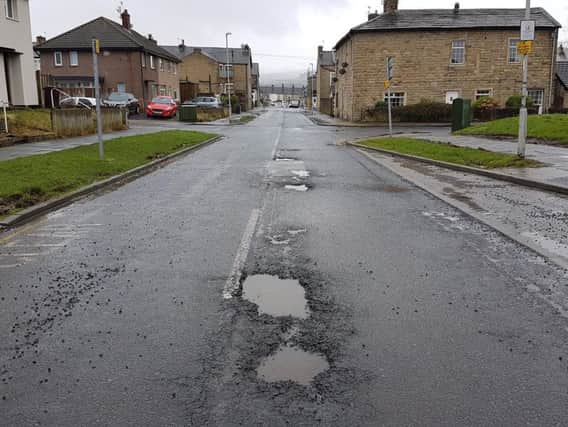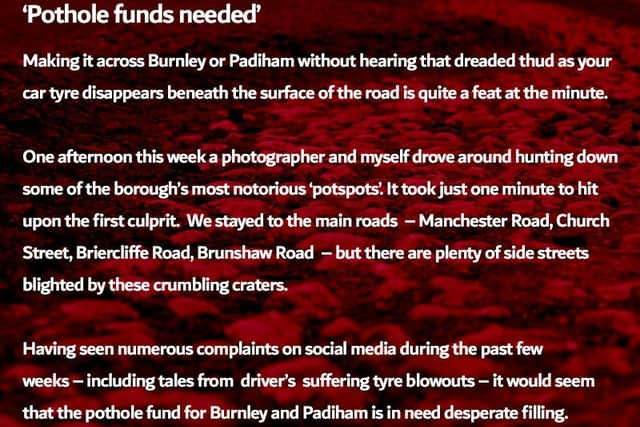Pothole hell driving Burnley motorists around the bend


Julie Cooper is now demanding more money be spent on the “shocking roads” as she accused Lancashire County Council of neglecting the borough in favour of more affluent areas.
A graph posted on social media by Burnley Council leader Mark Townsend indicated that £1.4m had been spent on the Ribble Valley’s road maintenance between April – December compared to just £300,000 in Burnley.
Advertisement
Hide AdAdvertisement
Hide AdMrs Cooper branded the figures a disgrace and said it was only a matter of time before a fatality occurred due to motorists taking evasive action


“It is a truly atrocious state of affairs, many of the roads in Burnley and surrounding areas are no longer fit for purpose. I, and the many constituents who have contacted me have never seen the roads in such a shocking condition.
“This county council stood in the last County Council elections promising to invest in the County’s roads, indeed County Council leader Geoff Driver was quoted in this paper in May last year, promising an extra £10 million to top up the Highways budget for this purpose.
Advertisement
Hide AdAdvertisement
Hide Ad“What he neglected to tell residents in Burnley and Padiham was that 450% more of that would be spent in the affluent Ribble Valley with Burnley, Pendle and Hyndburn being left out in the cold.


“My constituents are suffering serious and costly damage to vehicles because LCC is failing in its duty. It is surely only a matter of time until fatalities occur as road users swerve to avoid the ever deepening craters.
“Drivers contribute around £40 bn of motoring based taxation a year and many will feel that this is poor value for money.” County Coun. Keith Iddon, lead member for highways and transport, said: “We allocate funding for road repairs according to their condition on a countywide basis rather than allocating a certain amount to each district.
“We analyse data collected during road surveys to inform how we prioritise investment and, in order to make our resources go further, focus on intervening at the right time with the right treatment.
Advertisement
Hide AdAdvertisement
Hide Ad“The system is working well across the county as the condition of our roads is gradually improving, with fewer defects being found in A, B and C roads.
“The wet and freezing weather we’ve experienced in the last few weeks has led to an increase in potholes, as is the case every winter, and our teams are working hard to repair them.
“As the weather improves there will be fewer potholes appearing. However, our immediate priority is to keep our roads in a safe condition and respond as quickly as we can to repair the winter potholes.
Advertisement
Hide AdAdvertisement
Hide Ad“This year we increased the budget for highway repairs by £5m and will be proposing to increase the budget by a further £5m in the budget to be considered by council this week.”
The council’s pothole repair policy was revised at a recent Cabinet meeting with priority now being given to roads which are used the most.
The policy introduces a new target to fix potholes or other defects which are 15cm or greater in depth, and 30cm wide, within one working day – with five-day, 10-day and 20-day targets for less serious problems.
“We have inspectors working year-round to check our roads are safe. Our repair gangs fix any defects found from this work as well as responding to reports from the public.
Advertisement
Hide AdAdvertisement
Hide Ad“Safety is always our top priority, and we already aim to respond quickly to serious defects and emergency situations.
“However the way we currently monitor performance does not reflect this risk-based approach, as the target we set ourselves is to repair all potholes within 20 working days. Whilst this is a good thing to achieve, it is also important that we prioritise the most serious defects and busiest roads and the revised policy makes this much clearer.”